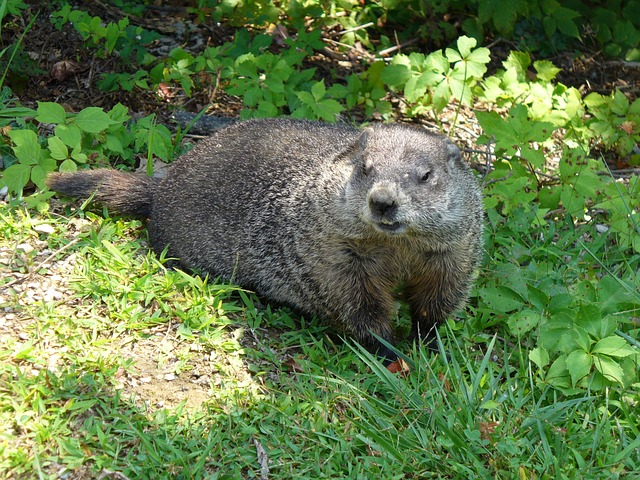Groundhogs and woodchucks are two names that are often used interchangeably, leading to the obvious question of whether they are the same animal or not. The answer is yes, groundhog and woodchuck are different names for the same animal, known scientifically as (Marmota monax). The different names, which also include whistle pig and land beaver, likely come from different etymologies from around North America. The name whistle-pig likely has to do with the fact that when a groundhog is alarmed, it will produce a shrill whistle that warns the rest of the colony of the potential danger.
Groundhogs or woodchucks are one of 15 marmot species that are found in Europe, Asia, and North America. However, not all marmots are groundhogs.
The range of the groundhog begins in southeastern Alaska and the Yukon Territory and extends generally southeastward. Other than a spur down into northern Idaho, groundhogs are mostly confined to the central and eastern states within the contiguous United States.
Why are they called woodchucks?
Everyone has attempted to repeat or at least heard the tongue twister, ” How much wood would a woodchuck chuck if a woodchuck could chuck wood?” The answer to that question is probably none.
Woodchucks are omnivores that feed on vegetation such as grasses, alfalfa, clovers, fruits, and even vegetables from your garden. In the early morning and the late afternoon, you see them out grazing for these food sources. In the early spring, when other vegetation is scarce, they might eat tree bark and even twigs. However, woodchucks are not heavy consumers of wood.
Being omnivores, they also consume protein from such sources as bird eggs, small rodents, insects, amphibians, and reptiles.
Getting back to where the term woodchuck comes from, the name is probably derived from terms that Native Americans used to describe the animal. For example, the Cree Indian word’s wuchak and otcheck, the Algonquian word, wuchak, and the Narragansett word ‘ockqutchaun are all words to describe the groundhog or woodchuck. See
With the arrival of English settlers to North America, these Native American terms probably devolved into woodchuck. See
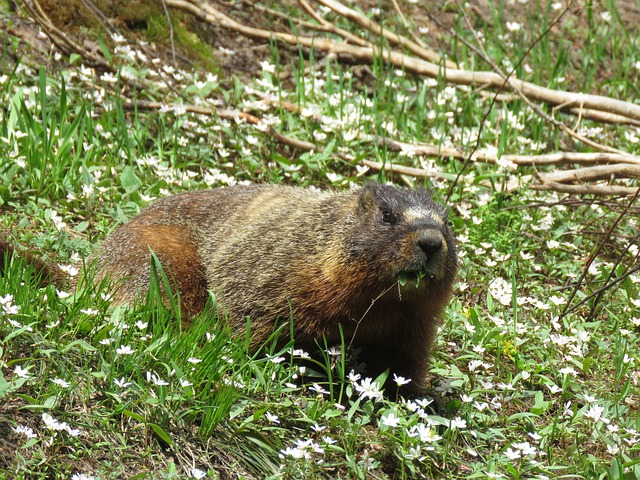
Physical characteristics
The groundhog is a large-sized, stocky ground squirrel. They are slightly larger in size than an average house cat. Adult woodchucks range in length from 16 to 27 inches and weigh between four and 14 pounds. They display sexual dimorphism, with average males being slightly larger than average female groundhogs.
Their thick fur varies in color from a yellowish brown to grizzled brownish black on their backs down their sides but is much paler on the underside.
They also have short ears, a blunt nose, and somewhat protruding upper incisors. Additionally, they have a bushy flat-topped tail.
A Groundhog’s body is well adapted for building underground burrows. For instance, they have short strong legs with flattened feet on the ends. What’s more, they have long, curved sharp claws on their front feet that are good for digging. Astley, their ears have flaps that close when they’re underground to keep out dirt. When groundhogs are digging burrows, they loosen the dirt in front of their face with their clawed front feet, then they pick the dirt up in their mouths, back out of the burrow, and deposit it above ground.
Like other rodents, these animals have incisors that continuously grow. In fact, if their incisors are not aligned so that they wear properly, these teeth will grow around 1/16th of an inch each week. This situation creates the possibility of the upper incisors growing into long tusks that can impale their lower jaw with fatal results.
Woodchuck Burrows
Woodchucks or groundhogs are known for their impressive burrowing abilities and the intricate architecture of their underground homes. They create complex burrow systems with multiple chambers that can be up to 65 feet long and have multiple above-ground entrances. These burrows provide shelter from predators and harsh weather conditions. They also store food in their burrows.
Groundhogs hibernate for around 3 months in the winter. In their burrow, they construct a hibernation den which they line with grass for insulation.
Food and Diet
Woodchucks or groundhogs are omnivores and primarily eat vegetation. Their diet consists of grasses, clover, and other plants. They are known to be a nuisance in the vegetable garden and other areas where plants are grown. In the wild, they forage for food during the day and retreat to their burrows at night. Being omnivores, they also consume protein from such sources as bird eggs, small rodents, insects, amphibians, and reptiles.
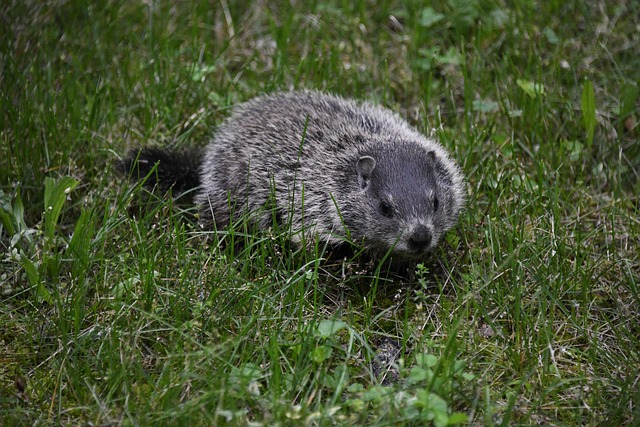
Groundhog Young and Breeding
Breeding Season
Groundhogs tend to be solitary creatures, with the exception of when the mother is raising her young and also during the breeding season.
Most groundhogs breed in their second year. However, some breed in their first year. During the breeding season, which typically begins in March and lasts through late April, male groundhogs establish territories and seek out female mates. Males will often fight with other males for the right to mate with a female. Groundhogs are polygamous animals, and dominant males will mate with multiple females during the breeding season. See
Groundhogs have a gestation period of approximately 31 to 32 days. After mating in early spring, female woodchucks and groundhogs give birth to litters of four to six young, called kits or cubs, in late April or early May. The baby groundhogs are born hairless, blind, and helpless, and they weigh about one ounce each.
Young Groundhogs
The young woodchucks stay in the burrow with their mother for about two months, during which time they are nursed and cared for. They are weaned at around six weeks of age, and by eight weeks, they are ready to leave the burrow and explore the world outside.
Territorial Behavior
Groundhogs are solitary animals, with the exception of during the breeding season. What’s more, they have oral scent glands on the sides of their face that they use to mark the boundaries of their home ranges. A single groundhog will fight to defend its burrow from any intruders. However, female groundhogs sometimes allow their female offspring from the previous year to share their burrows.
Male groundhogs are polygamous. In other words, they mate with multiple partners. Dominant male groundhogs are territorial and will defend their territory against other males.
The male territory is non-overlapping. However, the territory of one dominant male may overlap with the territories of as many as three females.
Other Marmot Species in North America
Groundhogs are North American members of the (Marmota) genus. Marmots are, in turn, the largest member of the squirrel family (Sciuridae), which also includes all other ground squirrels, all tree squirrels, and prairie dogs. Essentially, marmots are giant ground squirrels. There are 14 other species of marmots found worldwide. Five of these reside in North America. They are as follows:
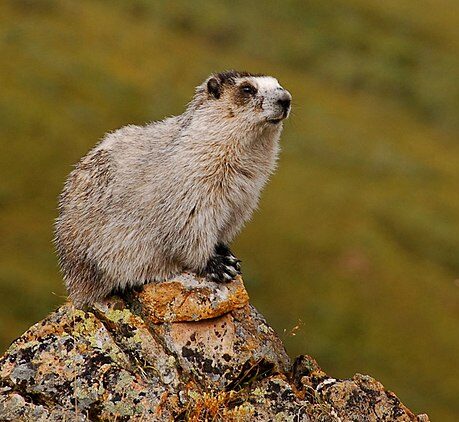
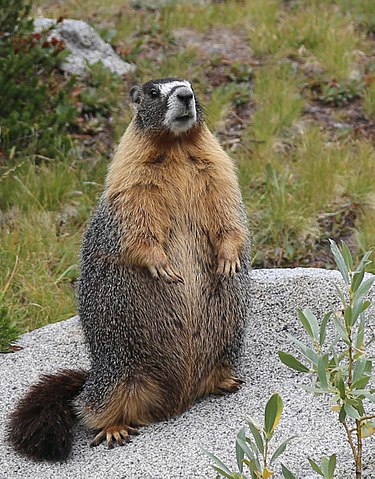
- Alaska Marmot (Marmota broweri) These marmots are found in Alaska.
- Hoary Marmot (Marmota caligata) These marmots reside in Alaska, the Yukon, British Columbia, Alberta, Washington State, and Montana.
- Yellow-bellied Marmot (Marmota flaviventris) These marmots live in southwestern Canada and the western United States. Many yellow-bellied marmots live at high elevations in the Rocky Mountain west and often live among talus rock or boulder fields. This gives impetus to their “rock chuck” nickname that they are known by in some areas.
- Olympic Marmot (Marmota olympus) This marmot is native to the Olympic Peninsula in Washington State.
- Vancouver Island Marmot (Marmota vancouverensis) This marmot is native to British Columbia’s Vancouver Island.
Groundhog Day
Groundhog Day is a cultural holiday that takes place on February 2nd in the United States and Canada. The holiday is based on the belief that if a groundhog emerges from its burrow on this day and sees its shadow, there will be six more weeks of winter. The most famous groundhog associated with Groundhog Day is Punxsutawney Phil, who is celebrated in Punxsutawney, Pennsylvania.
Punxsutawney Phil
Punxsutawney Phil is the most famous groundhog in North America. Every year on February 2nd, he emerges from his burrow in Punxsutawney, Pennsylvania, to predict the weather. According to tradition, if he sees his shadow, there will be six more weeks of winter. Punxsutawney Phil has been predicting the weather since 1887 and has become an American cultural icon.
Groundhog Winter Habits
Winter Hibernation and Sleep
Groundhogs are one of the few animals that enter into true hibernation in the winter months. They often build a separate winter den to hibernate in. In instances where they don’t build a separate winter burrow, they cordon off a hibernation chamber.
During the time of their winter sleep, their body temperature drops from around 99 degrees to as low as 35 degrees Fahrenheit, and their heart rate slows down from around 80 beats per minute to 5. Once more, their respiration slows down to one breath every six minutes. They enter a state of torpor, which is a deep sleep-like state that allows them to conserve energy and survive the winter.
To prepare for wintertime hibernation, groundhogs go through a period of hyperphagia in the fall. When a groundhog is in a hyperphagic state, it may consume as much as a pound of vegetation in one meal, or in other words, around 8% of its body weight. This is akin to a 200-pound man consuming 16 pounds of food at each sitting. They will lose as much as 50% of their total body weight by the time they emerge from their winter burrows.
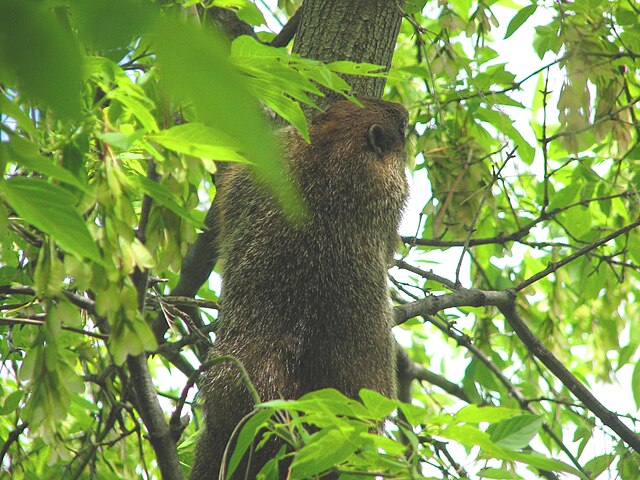
Groundhog Predators and Threats
Natural Predators
Groundhogs have many natural predators in the wild. Depending on the geographic area, some of the common predators of woodchucks include bears, mountain lions, wolves, coyotes, foxes, bobcats, and hawks.
Groundhogs are good climbers and can escape from predators or survey their territories by climbing trees. They’re also surprisingly good swimmers. However, they are vulnerable when they are on the ground.
Human Threats
Humans pose a significant threat to groundhogs. Groundhogs are nuisance animals. In rural and suburban areas, they sometimes do significant damage to pastures, farm fields, gardens, and human-made structures. They are often trapped and relocated or killed. Snares, live traps, and foothold traps are commonly used to capture groundhogs, and they are then released in different locations.
Motorized vehicles are also a significant threat to woodchucks and groundhogs. They are often hit by cars and other vehicles when crossing roads. In addition, humans may destroy woodchuck and groundhog burrows when they are building homes or other structures.
Frequently Asked Questions
What’s the difference between a groundhog and a woodchuck?
Groundhogs and woodchucks are not different animals. They are common terms used for the same animal, Marmota monax. They are also known as whistle-pigs, land-beavers, and marmots. The only difference is that woodchuck is a colloquial name, while groundhog is the common name.
Why is a groundhog called a woodchuck?
The name “woodchuck” is derived from the Algonquian word “wuchak,” which means “digger.” The name “groundhog” comes from their habit of burrowing into the ground.
What’s the difference between a marmot and a groundhog?
Marmots are a group of large ground squirrels that belong to the genus Marmota. Groundhogs, also known as woodchucks, are a species of marmot.
How to get rid of a groundhog?
There are several ways to get rid of groundhogs, including snaring, trapping, fencing, and repellents. However, it is important to note that in some states, groundhogs are considered varmints and can be hunted and or trapped without a license, while in others, it is illegal to kill them without a permit.
Are woodchucks dangerous?
Woodchucks are generally not dangerous to humans. However, they can cause damage to gardens, crops, and buildings with their burrowing activities.
What does a woodchuck eat?
Woodchucks are omnivores and primarily feed on grasses, clovers, dandelions, and other vegetation. They may also eat fruits and vegetables if available. Being omnivores, they also consume protein from such sources as bird eggs, small rodents, insects, amphibians, and reptiles.
Recent Posts
The only venomous snakes in Washington State are Northern Pacific Rattlesnakes. The Northern Pacific Rattlesnake (Crotalus oreganus oreganus) is a sub-species of the Western Rattlesnake. Anyone...
Skunks are not classified as true hibernators. But they go into a state of torpor when the weather gets cold. Skunks are light sleep hibernators, along with opossums, bears, and raccoons. ...

